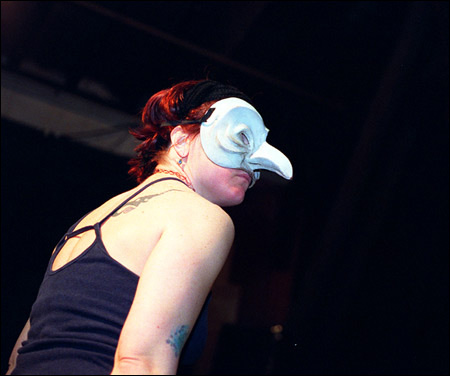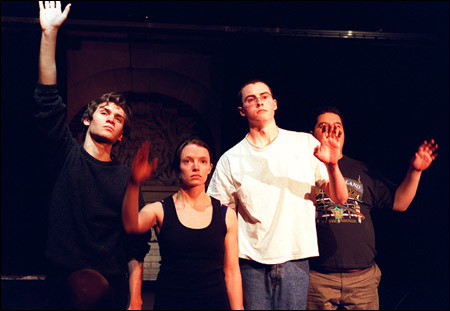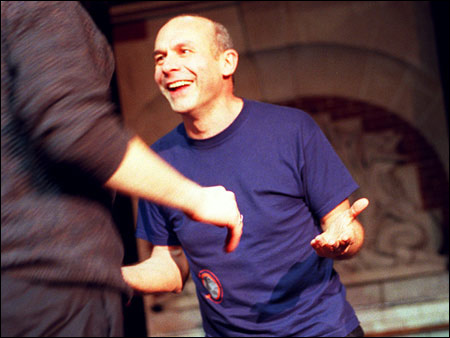Louder than words:
Sylvio Castiglioni teaches students about commedia dell’arte

Sylvio Castiglioni announced to a group of students that they would start off with “the oldest game in the world: I do, you repeat.” The 35 minutes that followed looked like the movement-based equivalent of a gospel choir face-off as the pack imitated Castiglioni, then alternate leaders, in a succession of lunges, squats, stomps, tumbles, and contortions.
The 15 undergraduates had convened on one of the coldest nights of the year at the Adams House Pool Theater for the first of three lessons with a master. The frenzied acrobatics of the kickoff exercise were merely an introduction to acting in the commedia dell’arte tradition. Castiglioni, a leading practitioner of the venerable yet antic method, led the workshops last week as part of the Learning From Performers series, run by the Office for the Arts (OFA). He has been in residence at the American Repertory Theatre (ART) for five weeks directing second-year students at the Institute for Advanced Theatre Training in a show they will perform at the Moscow Art Theater in March.
When Tom Lee, program manager for Learning From Performers at the OFA, heard about Castiglioni’s visit, it quickly became an opportunity for students to study with an expert. Castiglioni has trained with, among others, the legendary Polish director Jerzy Grotowski, and performs regularly at home in Italy and abroad. Also, for the past 10 years, he has been involved with the Sant’Arcangelo Theatre Festival, Italy’s most prestigious festival for experimental works. He has served as artistic director there since 1998.

“Commedia dell’arte is the main tradition of the Italian theater. It has one fundamental characteristic: We know nothing about it so we make it up as we go along,” he told the students at the outset of what would be three nights of physically rigorous, thought-intensive exercises.
He snickered at his joke, but it’s actually an apt explanation of the technique, which is historically characterized by improvisation. Commedia dell’arte was popular in Europe in the 15th and 16th centuries. It started in Italy as the irreverent improvised street theater of jesters, but it evolved to become known today as the forerunner of modern theater. Practitioners were the first to charge money for performances and, since many companies were made up of families, women became a regular presence on stage.
In what is historically classified as commedia’s early phases, traveling acting troupes set up in town squares – first in Italy then in France – and performed comedies involving a cast of stock characters. Types included a pompous lecher known as “the captain,” old men characters (including the “doctor”), servant-jesters (among them, the naughty, clever Harlequin), and, of course, the lovers. Often an actor played the same character his whole life. (For the record, Castiglioni claims to be the Harlequin in spite of himself.)
Performances varied based on everything from a town’s politics to the weather. The farcical nature of the style, however, remained constant. This hallmark of commedia has been tapped by everyone from Shakespeare to Moliere to The Three Stooges to Seinfeld.
And the timelessness was demonstrated in the workshops. Students moved from brief imitation exercises as individuals to group imitation to improvising entire scenarios to games and challenges with masks. Judging by the their clever impromptu stories and the sweat dripping despite the room’s nearly arctic chill, it’s safe to say that they grasped the essence of Castiglioni’s lessons.
“What means most [in commedia] is bringing the body back, making the body and voice merge in the theater experience. The aim is to wake up the actor, make him understand where he is in space and time, and what is all around him, all his sensibilities. It’s not always enough to be alive and present. [Actors] need instruments to become conscious of self.
“Being aware of your body allows your unconscious to emerge. When you’re spontaneous, you’re bringing your unconscious onto the stage as well, but you must study how to bring it out. Being natural on stage is a conquest. It doesn’t come naturally,” he said before the first workshop. Castiglioni, who at once possesses the dignity of Yul Brynner and the roguishness of Steve Buscemi, speaks English with the assistance of a translator, Gloria Pastorino, a lecturer in the History and Literature Department.

He went on to explain that commedia is grounded in physical work because on stage, it’s up to the body to give the brain material to develop. Such work is aided by the use of masks, a signature of the tradition.
“To help wake up the actor we use masks, which are used in teaching but not in productions. They guide an actor’s consciousness of his presence,” he said. “When you switch off your face, the body becomes the intelligence for the face. This is good. Sometimes the body gives expression for the face. Masks teach discretion. The actor is immediately aware that his new character has a certain way to maneuver his hands and legs. And an actor’s primary professional responsibility is to be conscious.”
The OFA’s Lee watched each night. “It’s been a wonderful progression from basic improvisation to formal use of masks. It was abstract at first with improv games, and [Castiglioni] had them plunge right in without much explanation, which allowed for real self-exploration for the students,” he said.
For their part, the students, who spanned a range of acting experience, relished the occasion to give their unconscious full reign. They also saw the workshops as a rare opportunity to partake in a hands-on history lesson.
“There are so many newer edges of theater so it’s interesting to look back for perspectives and see how they’re very much alive, not very far removed from what we’re doing. It enriches the experience because you have these historic concepts of theater blended with the new ideas,” said Jojo Karlin ’05.
The theories of commedia were especially intriguing to Emily Knapp ’03. “I came [to the workshops] from a practical standpoint, to learn techniques and be able to use them. I was pleasantly surprised at the amount of theory behind them. The amazing thing about the technique is that you’re able to throw yourself into it whole-hog from the beginning and progress quickly with organic spontaneity. [In practice,] it’s more impulsive than calculated,” she said.
At the close of the final night, the master gave in to the group’s exhortations, slipped on a mask like a second skin, and launched into a blustering narrative with wild gesticulations. The audience sat back and watched a hero’s ludicrous saga. The fact that Castiglioni told the tale in whip-speed Italian made no difference to the students, who raised eyebrows in delight and laughed at key moments in the story. Just goes to show: Body language speaks volumes and it happens to be Castiglioni’s lingua franca.




